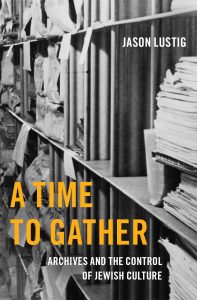
A Time to Gather: Archives and the Control of Jewish Culture argues that archiving emerged in modern times as an especially potent way for Jews to engage with their past. It examines these developments primarily in Germany, the United States, and Israel/Palestine, from the turn of the twentieth century to the cusp of the digital era. The history of Jewish archives on its largest scale, though, clearly extends around the world.
This research guide supplements the book with three main components: First, it presents a brief introduction to the development of archives in Jewish cultures that emphasizes the active role of archives in many contexts, and contextualizes how the records of Jewish history have made their way to our present day. Second, it offers details on important historical collections including the Cairo Genizah and Emanuel Ringelblum’s “Oyneg Shabes” Warsaw ghetto archive. And finally, it brings together a directory of contemporary archival institutions dedicated to Jewish history, both as a practical resource and also to illustrate what it means to speak of “a time to gather” in Jewish culture through the tremendous explosion of archival activity that continues into our own day—and which makes any attempt to create a directory of archives (as offered here in part) both useful, since the materials of Jewish history are scattered in so many repositories, but also impossible, as the archives of Jewish history have multiplied so magnificently.
This research guide underlines a key argument in the book, stressing the active role of archives in the shaping of Jewish culture; it is not just a list of places one can pursue research, but presents hundreds of different stories about how Jews have sought to control their culture and shape their history, and thus determine their destiny.
The story of Jewish archives offers a diverse and dynamic history that reflects Jewish history on the largest scale possible. Such repositories store the materials of Jewish history itself, of course, but one may also say that the history of Jewish archives is Jewish history. The development of Jewish archives around the world offers direct evidence of the continual processes of diaspora, migration, and movement. And the tremendous proliferation of archival initiatives in modern times—whether we look to the twentieth-century cases considered in the book, or the more than one hundred archival repositories listed in this guide—indicates the continually burning impulse to collect and preserve the materials of Jewish history in such a “time to gather.”